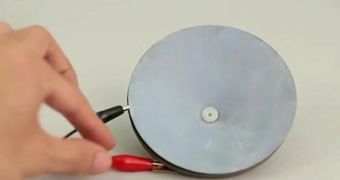You'd think that it would take a bit longer for actual, sophisticated electronics to be made in a single session via 3D printing technology, but Disney Research has just proved that it might not take that long at all.
Indeed, Disney Research, or two of its (former) members, has introduced a new technology that enables one to 3D print electrostatic speakers in any shape you can think of.
Although calling it a “new” technology is a bit of a stretch because it is not, in fact, new at all, but 75 years old or so.
Well, the 3D printing technology kind of is, but electrostatic speakers have been around for three quarters of a decade.
They are speakers which have no moving parts but can function, produce sound, anyway, and in a variety of situations too.
To elaborate, a membrane suspended in an electrostatic field produces sound based on the force of its exertion.
Mostly, these things are used to produce the sounds of chirping birds, squeaky noises and even ultrasound, because they have no bass, so they don't do well in normal circumstances.
Still, speakers are speakers, electronics devices as it were (as debatable as it is for this particular type), so the fact that they have been successfully 3D printed is noteworthy.
Yoshio Ishiguro and Ivan Poupyrev are the ones who came up with the technology, though they are no longer with Pittsburgh-based Disney Research.
Some traditional manufacturing methods were still used in the production process, but they should no longer be needed by the time five or ten years have passed.
There is already a 3D printing process capable of creating electrodes and electrical circuits, one made by Rabbit Photo, so the two inventors might end up using that, or something along similar lines.
In any event, we can safely say that electronics are no longer outside the reach of 3D printing experts, so we might get to witness a major overhaul of manufacturing technologies in the near to mid-term future.
It probably won't do much good to the general unemployment rates, since automation tends to kill job offers, but that issue should cause less and less damage the better economy becomes.
Toys are the first things that come to mind when pondering practical applications for the 3D printed electrostatic speaker. They could, say, let action figures and game pieces track each other. Sure, the first 3D printed electrostatic speaker is a bit too large for that, but it should be simple enough to make it smaller.

 14 DAY TRIAL //
14 DAY TRIAL // 